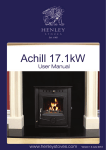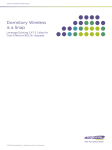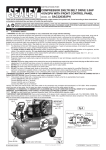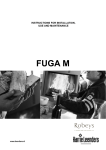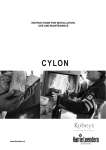Download FUTURE FIRES OPERATING INSTRUCTIONS PanoramicFX1
Transcript
FUTURE FIRES OPERATING INSTRUCTIONS PanoramicFX1 CONTENTS INSTALLATION INSTRUCTIONS Air Access Hearth Gaps between the PANORAMICFX1 and flammable materials Flooring Load-Bearing Flue Pipe Damper Connection to the Flue MODEL PANORAMICFX1 WEIGHT 70 KG OUTPUT MAX. 8 KWs mean SPACE HEATING OUTPUT 8 KWs mean FLUE MASS GAS FLOW 7.6 MEAN Tests carried out at 12 Pa flue draught (0.048 inches WG) with doors closed Tests carried out with primary air slider fully open and with restriction on secondary air supply (6mm diameter hole left open) OPERATIONAL INSTRUCTIONS Lighting Preparation Temperature Control Fuel to use Cleaning the glass Smoke Maintenance of the PANORAMICFX1 Trouble shooting INSTALLATION OF YOUR PANORAMICFX1 Before installing your stove, you should check with a Chimney Sweep to ensure that there is proper ventilation and to identify any possible damage to the chimney that might need repairing prior to installation. The chimney needs to be free of any obstructions and is appropriate for the woodburning stove. Sweep the chimney. Do a smoke test to check for draft and gas tightness. All installations of the PANORAMICFX1 must comply with relevant Building Regulations (eg Document J). These are available for download at http://www.planningportal.gov.uk/uploads/br/BR_PDF_ADJ_2002.pdf All local regulations, including those referring to national and European standards need to be complied with when installing the appliance. Air Access A minimum requirement is that there should be a steady supply of air to the room containing the stove. Any air inlet grilles need to be so positioned that they are not liable to blockage There must be fixed ventilation available. Refer to the building regs (ADJ) which give the requirements for roomheaters of differing outputs. Hearth The stove should be installed on a non-combustible hearth. The hearths themselves should be constructed of suitably robust materials and to appropriate dimensions that in normal use it prevents fabrics catching fire and people getting burnt. In the case of the PANORAMICFX1, the hearth should be of 225mm in front of the stove and 150 mm to each side measured from the door of the combustion chamber. Hearth Installation Gaps between the PANORAMICFX1 and flammable materials When installing your PANORAMICFX1 woodburning stove, a minimum space of 250mm at the side and a minimum of 400mm at the rear needs to be allowed between the stove and any inflammable materials. Any walls close to the stove should naturally not be flammable. There should be a gap between a flue pipe that is not insulated and anything flammable. This gap should be a minimum of 3 x the outside diameter of the flue pipe (375mm for 5” single wall flue pipe), or 1.5 x the flue diameter (375mm for 5” single wall flue pipe) to non combustible surface. Flooring Load-Bearing Prior to the installation of the PANORAMICFX1, investigation must be made to make sure that the floor can stand the weight of the stove and ancilliaries. The weight of the stove is xxxxxxxx Flue Pipe Damper If the chimney has a strong updraft, then it should be fitted with a flue pipe damper or draft stabilizers, to regulate draft. This must always allow for a 20% opening. Connection to the Flue The PANORAMICFX1 has a connection at the rear and top. The flue connections need to be sealed with fire cement or equivalent. The flue blanking plug should be positioned over the unused outlet. The PANORAMICFX1 is not suitable for a shared flue The flue gas temperature directly downstream of the flue spigot/socket in °C, (with closed firedoors), under nominal heat output conditions is 261Degrees Centigrade There is a need to provide access for cleaning the appliance, the flue gas connector and the chimney flue. A register plate This is the plate used to seal off the throat of the fireplace and has a hole for the flue pipe, access for sweeping and, if required, a bracket to support the flue pipe. The 5” flue pipe needed to go from the stove to the register plate. Prior to using the product the installation must be approved by a qualified person. Instructions for mounting, installation and use are enclosed with the product. The installation may only be used once it has been inspected and approved. OPERATING INSTRUCTIONS All local regulations, including those referring to national and European standards need to be complied with when installing the appliance Lighting Preparation It is recommended that windows and doors are opened when lighting the stove for the first time. Ensure that firebricks and other internal components are in position and that all packaging has been removed. The process for lighting the stove is as follows: a) Ensure that the bottom air control is open fullyb) Put some paper/newspaper at the back/bottom of the stove. Place some small pieces of wood on top of the paper and larger pieces on top of this. When ready, light the paper and ensure that the door is fully closed and locked. Do not try to run the PANORAMICFX1 with the door ajar. c) Once the wood is fully lit, then bigger pieces of wood can be added, as required. d) When the fire is burning well, then regulate the fire with the bottom air control. Do not try to put in too much wood at the start. Aim for a small hot fire. If a large piece is added, increase the top vent to compensate. Warnings Keep the door closed except during ignition, refuelling and removal of residue material. All parts of the appliance, especially the external surfaces, will be hot to touch when in operation and due care will need to be taken Do not make any unauthorised modification of the appliance The use of only replacement parts recommended by the manufacturer In case of a chimney fire take appropriate action, including: In the event of a chimney fire occurring: • • • • • • Dial 999 and ask for the Fire Service (there is no charge) Close down the ventilation as much as possible. Move furniture & rugs away from the fireplace and remove any nearby ornaments. Feel the chimney breast in other rooms for signs of heat. If a wall is becoming hot, move furniture away. Ensure that access to your attic or roof space is available for the Fire Service as they will want to thoroughly check this area for signs of possible fire spread. The PANORAMICFX1 appliance is not suitable for installation in a shared flue system The appliance is capable of intermittent operation only . Temperature Control The temperature that your PANORAMICFX1 burns at can significantly impact on it’s performance. For example, the most efficient temperature for your stove to burn at is 115 °C - 245°C. Below this level, may result in the inefficient burning of the fuel and could start to build up residue in the chimney and on the glass door at the front. Above this temperature and the heat may cause damage to the PANORAMICFX1 and potentially cause a fire hazard with residue in the chimney. We would recommend the purchase of a wood stove thermometer to ensure that these issues are monitored and addressed. 8kW output is achieved with the primary air fully open and secondary air at ~ 20% open (assuming that you fit a control to the secondary air) Fuel to use As with other wood burning stoves, seasoned wood needs to be used in the PANORAMICFX1. This is wood that has been dried for at least 6-12 months. It should be cut to size and stacked ideally under cover with gaps at the side to allow for wind/drying air. Cleaning the glass The glass should be cleaned/wiped with a paper towel ideally after each fire, to avoid residue building up. Smoke Wood can release pollutants into the atmosphere when poor burning techniques are used. The hazards include smoke and carbon monoxide. Ventilation A minimum requirement is that there should be a steady supply of air to the room containing the stove. Any air inlet grilles need to be so positioned that they are not liable to blockage There must be fixed ventilation available. Refer to the building regs (ADJ) which give the requirements for roomheaters of differing outputs. There should be adequate provision of combustion and ventilation air and air intake grilles supplying combustion air, should be kept free from blockage; Smoke consists of particles of unburned wood which form as a result of incomplete combustion. It contains harmful pollutants that can trigger coughs, runny noses, headaches and eye and throat irritation. Unburned fuel can also be deposited as creosote in the chimney, providing the potential for a chimney fire. Smoke can also contribute to smog which is carcinogenic. Carbon monoxide (CO) is generated wherever combustion of a carbon based fuel occurs so that all gas, oil, coal and wood boilers as well as wood burning stoves have the potential to produce dangerous levels of CO gas if installed or operated incorrectly. The following good practice is suggested: • Burn small, hot fires - they produce much less smoke than ones that are left to smoulder. • • • • • • • • Burn seasoned wood. This is wood which has been allowed to try over at least one summer season. Green wood is a major culprit in the creation of creosote. Burn logs that are 10 -15 cm (4-6 inches) in diameter. Fires burn better with more surface area exposed to the flame. Never burn rubbish, plastics, cardboard, glossy paper or polystyrene. Never burn wood that has been taken from salt water. Chlorine combines with the smoke to produce dioxins and furans, which are dangerous carcinogens. Never burn treated or painted wood, particulate-board or plywood. Store wood outside, off the ground and covered. Bringing green wood indoors to dry can promote the growth of allergy-causing mould spores circulating indoors. Have the PANORAMICFX1 installed by a professional and have it inspected and cleaned every year. Make sure the fire is getting enough air - check that the air inlet is open wide enough to keep the fire burning briskly, resulting in complete combustion and less smoke. • • never use liquid fuels Occasional adverse weather conditions may cause a down draught during which it would be best not to use the appliance Malfunction In case of malfunction eg overheating, reduce air supply if practical, do not open the door, and keep a safe distance. Nb Running the stove with only the bottom air control open will provide oxygen for the wood to burn on the fire base but will not provide air for the volatile gases above the fire bed to combust, resulting in a smoky inefficient fire. The stove is not suitable for burning solid fuel ie. briquettes\ coal\coke\smokeless fuel. Note: The above notes on operating your stove should be taken as guidelines only. Each stove installation is unique and the operation of each stove is subject to many variables including; the fuel used, the size of the room, chimney performance, ventilation. As such, the best operation of your stove will be learned through experience only. Maintenance of the PANORAMICFX1 Maintenance of the PANORAMICFX1 should only be undertaken when the stove is completely cold. Regular Maintenance Requirements • External vacuuming of the stove/Clean with a soft brush should be undertaken every day if the stove is in regular use (Do not use any forms of chemical cleaning as this will damage the PANORAMICFX1). • The chimney should be swept at least once a year-this should include an inspection of the firebricks, handles, seals. There is also a need for regular cleaning of the appliance, of the flue gas connector and highlighting the need to check for blockage prior to re-lighting after a prolonged shut down period • Ashes should only be removed when the fire is out and has been left to cool completely. A thin layer of ash can be left in the bottom of the stove, as this can help to protect the firebrick underneath and help in the combustion process. • The internal firebricks may need replacing overtime, but only when they have deteriorated to the point of failing to insulate properly. • If the glass is blackened with soot, it can easily be cleaned using one of the many specialist stove glass cleaning products available from stove shops. Trouble shooting Symptom Residue on the Glass resulting in Darkening Smoke in the room when opening door High combustion levels Action • Only use seasoned dry wood • Ensure that the top air vent is being used once the fire is operating Run the stove at a higher temperature-bearing in mind suggested operating conditions • Only open the door when there are low flames • Check chimney • Make sure that flue gases exit at the rear of the stove • Check and replace seals (inc door) if required • Consult chimney sweep Warranty This stove has a two year guarantee covering any defects arising from faulty workmanship during normal use of the stove. The guarantee does not cover parts deemed to be replaceable in the normal usage of the stove. These include: Glass & Door rope seal & Fire Brick linings









